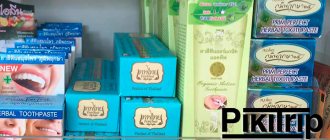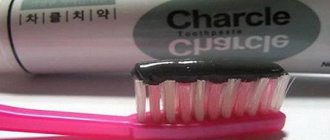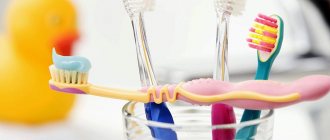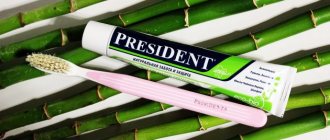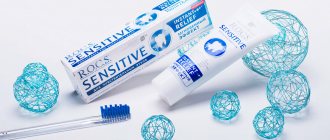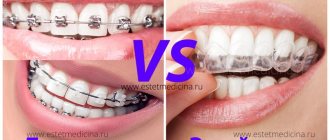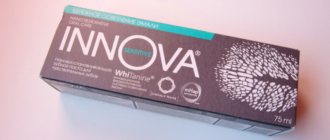Why is special paste for braces used?
The braces system covers a significant part of the teeth and allows food debris to get stuck in its spaces, as well as in places in contact with the teeth. They are quite difficult to remove, which promotes the growth of bacteria. And their activity causes the formation of plaque, stone and the development of caries. Plaque, in turn, can cause gum disease.
In order to enhance the protection of teeth when wearing braces, a special toothpaste is used. This way you can prevent various types of problems and diseases of the oral cavity.
Features of use
Due to prolonged wearing of braces, plaque often accumulates under the metal frame, which leads to caries. When the doctor removes the system, the patient may experience pulpitis. During this period, high-quality cleaning products are selected that prevent the development of caries.
Ordinary hygiene products cannot cope with the conditions. Therefore, therapeutic and preventive products are used to completely eliminate bacteria, fungi, and particles of food that have not been removed.
The substance can be applied using an electric toothbrush, which cleans the interdental spaces more thoroughly.
Attention!
Add the use of an irrigator. This is a device that delivers a stream of water under pressure into the interdental spaces. The liquid washes away stuck food and plaque.
What types of pastes are there?
Toothpaste can rightfully be called a medicinal product used to treat teeth and gums, as well as to prevent their diseases. This product should be used at least twice a day.
To choose the right cleaning product, it is important to know what it consists of.
Main components of the paste:
- abrasive;
- medicinal components;
- flavoring and aromatic fragrances;
- fillers;
- special additives.
Depending on what components are contained in the paste, it comes in two types: hygienic and therapeutic and prophylactic.
The first type has no active medicinal components. Its main purpose is to remove plaque from enamel and provide fresh breath. It is advisable to use such compositions in patients who do not have oral diseases and who regularly visit dentistry to prevent the development of caries.
Hygienic cleaning products usually have a gel consistency containing silicon oxide. They taste good and are easy to lather. At the same time, chalk-based mixtures for cleaning teeth perform their functions much better.
The therapeutic and prophylactic paste, in addition to cleansing, suppresses pathogenic microflora in the oral cavity, remineralizes enamel and reduces gum inflammation. Such mixtures often contain bleaching components.
Therapeutic and prophylactic cleaning agents are of the following types:
- anti-caries (may contain fluoride);
- desensitizing, eliminating hypersensitivity;
- having an anti-inflammatory effect;
- whitening;
- sorption (contain enterosgel);
- organic.
Paste composition
The composition may include the following chemical components:
- sodium lauryl sulfate - foams the substance so that it reaches distant areas, but can cause an allergic reaction;
- parabens, propylene glycol - preservatives designed to increase shelf life, but in high concentrations lead to cancer and toxic damage to cells;
- triclosan is an antibiotic that destroys bacteria and fungi;
- fluorine is a substance that enhances the strength of enamel and deeply cleanses the surface;
- abrasive components – eliminate plaque, prevent the development of stones, which can damage the enamel;
- glycerin – moisturizes the mucous membrane;
- polyphosphate - makes the structure of the product thick, has toxicity to the gastrointestinal tract.
Note!
Many of these substances negatively affect the body in high concentrations. But without their addition, the product has less cleaning power.
Natural ingredients:
- plant extracts (chamomile, calendula, coltsfoot, sage, mint, oak bark) - relieve inflammation, destroy bacteria and fungi, moisturize, saturate tissues with vitamins and minerals;
- clay – eliminates plaque, cleanses without destroying enamel;
- sea salt – saturates tissues with microelements;
- vitamins – enhance metabolism, increasing the regenerative ability of cells;
- ginger, cloves – destroy pathogenic microorganisms;
- lemon – gently whitens without destroying enamel;
- silicon, calcium and other minerals – increasing the strength of enamel, preventing caries.
This is interesting: Does toothpaste help with acne?
Depending on the condition of the patient’s teeth, the doctor prescribes a product with a certain composition. If he is predisposed to caries, use a paste with minerals, fluorides, and abrasive elements. If there is periodontitis caused by wearing braces, a product containing substances that relieve inflammation is applied.
Main components
Let's consider the purpose of the main components of teeth cleaning products.
The abrasive is a silicon compound. With its help, the process of cleaning dental elements from plaque is accelerated. It is important to brush your teeth correctly, and if the plaque does not go away, it does not mean that the problem is in the toothpaste. The amount of abrasive in different compositions differs, but in any case it is present there.
Patients with sensitive teeth are recommended to use cleaning compositions with a low content of this component.
The reasons for poor plaque cleansing can be: roughness of the enamel, coloring products used in food and smoking. For maximum teeth cleaning, use as much toothpaste as you can fit on your brush, then dip it in tooth powder. It is an abrasive in its purest form.
Therapeutic components are represented by fluorides, designed to fight caries. To have a positive effect, teeth must be in contact with the cleaning agent for at least five minutes.
Fluoride is contained in varying amounts in all toothpastes. When wearing braces, especially at the initial stage, it is recommended to use a composition with a low content of this component to prevent disruption of the adhesion of braces and enamel.
Rules for brushing teeth with braces
Complete hygiene procedures must be performed 2-3 times a day. After each meal, be sure to rinse your mouth. Let's take a step-by-step look at how to properly brush your teeth with braces.
- We start by cleaning the surface of the teeth with a V-shaped brush. To do this, we make sweeping movements from the gums in a vertical plane.
- Using a mono-beam brush, we remove food debris and plaque from the braces themselves and around them.
- Brushes are designed for more thorough cleaning of locks, interdental spaces and arches.
- Superflosses do an excellent job of removing plaque accumulated under a fixed orthodontic arch.
- An irrigator for braces is used not only for cleaning, but also for oxygenating tissues. The supply of liquid under pressure will ensure high-quality final cleaning of teeth from deposits.
- Using a regular toothbrush, remove plaque from the inner and chewing surfaces of the teeth.
- Finish the hygiene minimum by rinsing your mouth. For preventive purposes, it is better to use a regular mouthwash that has a deodorizing effect.
DETAILS: Metal braces are an inexpensive and most effective option for correcting a bite.
Orthodontic treatment using braces requires proper oral hygiene. Otherwise, there is a high probability that you will not be able to avoid the development of multiple caries and gingivitis. Therefore, follow all your doctor’s recommendations and visit your hygienist every six months for professional cleaning.
Special Additives
These types of enzymes help patients who cannot clean their teeth for the right time and quality. Such patients include those wearing braces and small children. The content of special additives in the cleaning composition helps to soften, foam, and then remove plaque. They clean teeth even in hard-to-reach places.
Whitening elements are represented by peroxides that enter into a slight chemical reaction with the surface of the teeth. The treated area becomes lighter. For patients wearing braces, toothpaste with whitening compounds is not recommended. After all, parts of the teeth covered with braces will not be whitened, and after removing the leveling systems, the smile will look very unattractive.
The patient may or may not like the toothpaste. Flavors and flavorings are quite important for humans. They use artificial and natural (menthol, carvacrol) components.
How to choose pasta?
When choosing a toothpaste, it is important not to pay attention to the beautiful packaging, but to read the composition on the label. First of all, you should pay attention to the fluoride and calcium content. Calcium strengthens tooth enamel, and fluoride fights caries.
When starting to wear an orthodontic structure, you need to select a composition with a low fluoride content.
The presence of enzymes also adds to the effectiveness of the cleaning composition. They dissolve food particles and remove plaque. But before using such cleaning products, it is better to consult a doctor.
List of the best pastes for braces
Dentists highlight a list of products that clean teeth while wearing braces:
- Gum Ortho – an anti-cavity agent with a minty flavor;
- Megasmile is a foam-based product that eliminates plaque in remote areas of the teeth;
- Interprox – anti-caries cleansing gel;
- Curasept is a chlorhexidine-based gel that destroys bacteria;
- Biorepair Junior – a cleaning product for children intended while wearing orthodontic appliances, does not contain fluoride;
- Green Eyes Microgranules - a gel that strengthens enamel and eliminates caries due to the content of granules;
- Pierrot Natural freshness is a product based on potassium nitrate, sodium chloride, aloe juice (destroys bacteria, strengthens enamel, eliminates inflammation).
This is interesting: How to choose toothpaste
The choice depends on the age of the patient. If this is a child, select a product that does not contain fluoride. For adults, abrasive components and fluoride are applied.
If a person has installed a teeth straightening system, change the toothpaste. It must include strong cleaning agents to remove plaque from distant parts of the teeth. During the treatment period, whitening components are used. For example, whitening powders for teeth and gums. They do not damage the structure; they only affect a person’s own tissues.
Using toothpaste
It is important to use toothpaste every time you brush your teeth. Squeeze the required amount of composition onto the brush and begin cleaning.
Whatever toothpaste you use, you need to brush your teeth for at least five minutes. Otherwise, the components will not have time to act on the surface being cleaned, and the paste will not be beneficial.
When cleaning, you need to pay attention to each tooth, and when wearing braces, you should clean the areas where they touch your teeth as much as possible. For hard-to-reach places, it is advisable to use special brushes in the form of brushes and an irrigator.
Toothpaste for braces: features and rating of the best products
When the orthodontist straightens the bite, he places special plates on the teeth. They create a barrier when cleaning. As a result, plaque accumulates on the surface of the enamel and a pathogenic bacterial environment is formed. If measures are not taken, this leads to the appearance of caries and periodontal disease. During the cleaning process, you will need a special toothpaste for braces. Let's talk about its features and give a rating of the best hygiene products.
The most recommended pastes for braces
Different doctors who install braces prefer different specialized pastes.
Let's look at the cleaning products that orthodontists most often recommend:
- Interprox is a gel recommended for cleaning spaces between teeth;
- Gum Ortho is a cleanser that contains a mint scent and actively protects against caries;
- Vitis Orthodontic Toothpaste is a cleaning product that has a healing effect and is suitable for daily use;
- Megasmile is a foam that actively protects against caries and plaque.
Which toothpaste should I choose if I have braces?
When treating with braces, you should choose a specific strategy aimed at protecting teeth from caries and preventing the onset of inflammatory processes in the oral cavity. For these purposes, the use of a certain type of paste is required that best copes with problems that arise at different stages of therapy.
Stage 1 . It has been proven that the first few months after installing braces, teeth begin to lose calcium with great intensity. Accordingly, during this period they need to make up for losses. In this case, using toothpaste with a high calcium content in its composition will help.
Stage 2 . The main, longest phase of treatment is characterized by a significant increase in the risk of caries. Using toothpaste with a high fluoride content will help prevent the appearance of pockets of carious tooth decay.
Stage 3 . The final stage of wearing braces requires the paste to contain soothing and anti-inflammatory components. Extracts of herbs, flowers, and oak bark best cope with inflammation in the oral cavity, simultaneously helping to eliminate various irritations of the gums.
Below we describe the most popular brands of toothpastes used when wearing braces.
- Interprox . It is a gel composition, the purpose of which is to care for the gums.
- Gum Ortho . Effectively prevents carious formations, has a not pronounced mint taste.
- Megasmile . Megasmile dental foam reduces the risk of caries and plaque.
- Vitis Orthodontic Toothpaste . Therapeutic toothpaste intended for everyday use.
Below we suggest watching a video on the topic:
Do I need to change my toothpaste while wearing braces?
It is necessary to change the paste, since addiction to its active components occurs quite quickly. Replacement should be done at least once every few months.
To strengthen tooth enamel, it is better to start with a composition containing calcium. Then the toothpaste is replaced with fluoride-containing one to protect teeth from caries. And towards the end of treatment, you can switch to a product with an anti-inflammatory effect, in order to protect the gums, or containing enzymes that can fight plaque.
When changing toothpastes, it is better to consult an orthodontist. He will recommend the most optimal types for you.
Actions of the ingredients
When choosing a paste, it is important to know what effect each of its elements has.
The abrasive helps clean plaque. The higher its content in the cleaning composition, the faster the cleansing occurs, but the risk of damage to the enamel also increases. But compositions with a low content of this component imply high-quality, but at the same time delicate care. For smokers, patients who eat dyed foods, and people with rough tooth surfaces, it can be difficult to get rid of plaque when using even a cleaning composition with a high abrasive content.
The healing ingredients are fluoride, which prevents tooth decay. Some doctors talk about the dangers of fluoride for humans. It kills pathogens that cause caries, but with constant use it can destroy the teeth themselves.
Special additives are used to soften plaque and remove it. They are especially important in children's toothpastes, because kids don't want to spend a lot of time brushing their teeth. For patients wearing braces, it is also important to choose a teeth cleaning product that contains special additives, since cleaning the oral cavity is complicated by the interfering structure.
Whitening enzymes are also special additives. Their main ingredient is peroxide, which acts as a chemical reaction. For patients with braces, formulations containing bleaching agents are contraindicated.
Flavorings are used to give the cleaning composition a pleasant taste. They can be natural (most recommended) or artificial.
